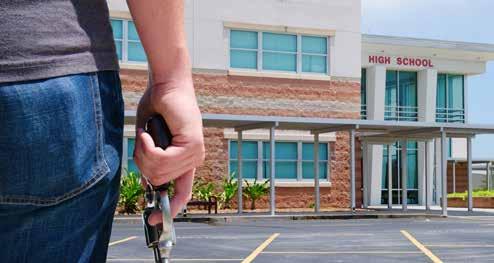
4 minute read
Lockdown logistics: Incident management and access control
Access control systems can do a whole lot more than preventing access to a site by some and facilitating it for others. Phil Murphy, Sales Manager for the South Island at Gallagher, talks about managing lockdowns with an access control system.
We can’t turn our schools into prisons; that’s not who we are as a nation - but we have a real duty of care to ensure that the safety of children while at school is treated as a priority. Caregivers should feel reassured that adequate measures are in place to protect their children and the staff on a site.
The recent Lockdown in Schools report from KPMG uncovered a litany of issues triggered by dealing with school shootings. Lack of communication was cited as one of the major reasons that lockdowns failed. The other was the failure to implement any actual lock down procedure or system.
A lack of training and policies are key factors for poor performance during lockdown - something which we can’t afford to compromise on. Only 60 percent of the schools featured in the report had used Ministry of Education guidance to create their own policies on how to manage a lockdown. More than 40 percent of senior staff in schools and early learning services hadn’t been trained in, or practiced, managing a lockdown.
Being able to respond rapidly to a situation and having the right tools and systems in place to do this can mean the difference between life and death.
The Ministry has produced a Planning and Preparing for Emergencies and Traumatic Incidents guide that details several points to consider when creating a lockdown policy. In this article, I hope to provide an understanding of how an access control system plays a vital part in such an event.

Phil Murphy, Gallagher's Sales Manager for the South Island.
Image supplied.
Prior to an evacuation, consider what might assist emergency services at the time of an emergency. Measures might include providing a master key or information on how to gain access, detailed floor plans of the site (which show entrances, windows, roof hatches and ventilation systems), and the estimated number of staff, children and young people on site and their likely location.
An access control system can hold information on who is on site and indicate where they are. An access system allows you to configure safe zones within a complex – ones that cannot be easily accessed by any unauthorised persons.
This information can be printed out quickly when required – or viewed remotely with secure access privilege or presented on a mobile device. A card reader at muster points (or a fully mobile reader) can also ensure anyone who has evacuated the building can badge in and a report can be printed quickly and easily.
A site lockdown can be as simple as pressing a button on a desk or on your mobile device. There can be multiple options here from whole-site to part-site lockdown.
Signalling a lockdown is of paramount importance and needs to be carefully thought out. In some cases, it may not be appropriate to sound an audible alarm.
If an audible alarm is used, consider whether the signal can be heard clearly from all locations in the school, including non-classroom situations such as the gymnasium or swimming pool. If the signal cannot be heard by some classes, for example those on outside playing fields, then alternative ways and options to communicate with staff may be required.
Broadcast notifications direct to mobile phones enable you to communicate simply and quickly with multiple people and in multiple groups – for instance, different notifications for parents and teachers.

In lockdown situations where children, students, and employees could be in danger, preconfigured broadcast notifications and recipient lists allow security personnel to send critical instructions to multiple recipients in one quick and simple step. Broadcast notifications can also be automatically triggered by alarms and events. The displays on readers can tell anyone trying to enter a building that the site is in lock down – preventing further unwary people from entering.
Using mobile access control readers not only allows access but can also the assist with the operation of lighting, air conditioning systems, and any electronic emergency equipment you may have, such as window shutters.
When there are visitors on site, such as contractors, a robust process for managing them is required. A good visitor/contractor management system will enable you to know exactly who is on the grounds and where during an emergency. A mobile reader can also help when challenging anyone who is on site to confirm if they are authorised or not.
Broadcast notifications received via the Gallagher Mobile Connect App, for example, provide a trusted source of legitimate information amongst increasing amounts of text message (SMS) and email spam. As a secure communication channel, the app also protects against the threat of hoax or malicious text messages designed to disrupt operations or, in a worst-case scenario, harm people.
Access control systems protect schools from threats through the power of the 4Ds:
• Deter - put them off
• Detect - know they are there
• Delay - restrict their movement
• Dispatch - alert emergency services swiftly.
A free starter kit license with integrated contractor/visitor manager software is available to any school that does not have a Gallagher system and that wants to use broadcast notifications and manage visitors to site. To find out how you can obtain this, or if you would like to find out more about access control in a lockdown situation, contact us at sales.nz@security.gallagher.com.










